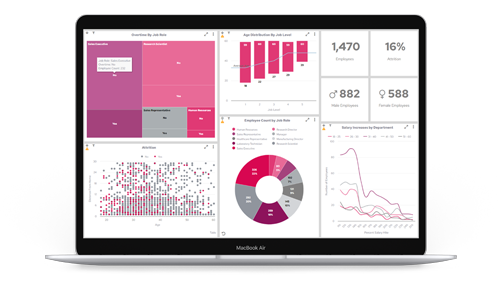The last 10 years have seen some paradigm-shifting evolutions in Fintech SaaS technology. Large Language Models, advanced APIs, and no-code/low-code have gone mainstream. Now, technologies like Causal AI are at the forefront of Fintech SaaS.
Together with advancements like embedded analytics—it’s poised to build an entirely new offering. These digital developments will create opportunities for those that take advantage of them—and risks for those that don’t.
In this blog, we’re diving into why Causal AI is so compelling for Fintech Saas—covering key benefits, use cases, and real-world case studies.
Psst. This blog forms part of a series dedicated to Fintech growth. We’ve interviewed experts from the likes of Starling Bank, FINBOURNE, incuto, Lenvi, Mutual Vision, OnePay, techUK, and Tred to bring in practical advice. (Links to additional blogs are at the end.)
Why Causal AI in Fintech SaaS is becoming a must-have
Causal AI is taking the Fintech SaaS market to a new level by offering a fresh, insightful approach to data analytics. In fact, it's projected to hit an expected market value of over $290 million by 2030. Already, 15% of SaaS vendors are jumping on board, integrating causal capabilities into their products.
Why? Because Causal AI is a step up from traditional correlation-based methods—delivering deeper insights into not just the outcomes but also the 'why' behind them. Solving this ‘black box’ issue is huge for Fintech SaaS, improving decision-making in finance, banking, and insurance, and refining risk models.
This tech goes beyond traditional AI by pinpointing the root causes behind data trends. It enables smarter, more transparent predictions, shifting data analytics from hindsight to foresight. With experts like Gartner hyping up its potential, embedding Causal AI is becoming a smart move for Fintech SaaS companies, helping them dive deeper into data for more personalized, clear financial solutions.
Ultimately, embracing Causal AI early can give Fintech SaaS vendors a serious edge in a market that values transparent, trustworthy AI.
So, why Causal AI (specifically)?
What sets Causal AI apart?
Causal AI really shines compared to traditional AI. It's all about digging deep to find the real causes behind data trends. Here's a closer look:
1. Enabling strategic foresight through explainable predictions:
Simply put, Causal AI goes beyond predictions. As we’ve briefly touched on, it tells you the 'why' behind expected outcomes. This is a game-changer for strategic planning. It's about real understanding, which builds trust and makes the predictions more actionable.
2. Battling bias head-on:
Causal AI does more than crunch numbers; it challenges and questions biases in the data. By revealing the causal relationships, it opens up a path to fairer and more ethical AI practices. For instance, in insurance, Causal AI could reveal that for young drivers, factors like the time of night they drive—rather than just their age—influence their insurance premiums. This kind of insight disrupts traditional assumptions and highlights specific areas for policy adjustments.
This blend of predictive power and transparency is incredibly valuable, especially in sectors like Fintech SaaS. Here, trust and clarity in data analytics are essential for informed decision-making and ethical practices.
Benefits of Causal AI in Fintech SaaS
Those that integrate Causal AI see benefits for both their business and the services they can provide to clients:
- Deeper financial insights: It brings a new level of transparency to money management, helping both businesses and their end-users better understand financial decisions.
- Answering the call for explainability: In a world where users and regulators are increasingly demanding clarity, Causal AI sheds light on the 'why' behind data outcomes, moving away from the opaque 'black box' approach.
- Ethical AI development: Causal AI encourages a more responsible approach to AI, allowing for the evaluation and questioning of underlying assumptions.
- Enhancing human input: It empowers staff across the board to examine and interact with models and data, leading to ongoing improvements in analytics.
- Democratizing AI model creation: By making model building accessible beyond data scientists, Causal AI surfaces collective intelligence, driving greater value.
Ultimately, these advantages position Fintech SaaS providers as leaders in offering transparent, ethical, and effective AI-enabled solutions. And that’s not the best bit. There are so few Fintech SaaS providers using Causal AI… Most are still using neural networks and regression modelling (which focus on correlation, not causation). So there’s a huge competitive advantage at your fingertips, right now.
To make this a little more concrete, let’s look at some practical use cases.
Causal AI in Fintech SaaS: Use cases
Here are just a handful of examples of applying Causal AI in Fintech SaaS:
- Spotting fraud smarter: It's not just finding fraud; it's figuring out what's causing it, making it way more effective at stopping it.
- Risk modeling on another level: By understanding the cause-and-effect of risks, it makes models for things like credit risk much sharper and more intelligent.
- Tweaking investment strategies: It helps in making investment systems that automatically adjust for the best returns, thanks to its deep dive into market trends.
- Figuring out customer loyalty: Causal AI digs into why customers might leave, helping to keep them around with better offers and experiences.
It's a big deal for everything from managing risks to advising clients and staying on top of regulations. For Fintech SaaS companies, getting into Causal AI is a smart move for staying ahead.

(Example of Causal AI in Pi Predict)
Causal AI and the future of Fintech SaaS
Fintech SaaS is being redefined by data-driven power shifts. And it doesn’t matter whether your organization buys into them or not. The shifts are happening. If you haven’t already felt their impact, it’s only a matter of time.
Causal AI brings a level of insight that's transparent, reliable, and impactful—shifting from simple correlation to deeper causality.
For Fintech SaaS providers looking to stand out, integrating Causal AI is crucial. It not only adds value by clarifying data drivers but also makes solutions more trustworthy. Early adopters of user-friendly Causal AI will gain a competitive edge, staying relevant and ahead of the curve.

6 steps to embed Causal AI
If you’re ready to start using a transparent and auditable predictive model builder today, embedded analytics is the key. It allows you to build an innovative embedded analytics experience and incorporate Causal AI directly into your apps, products, and services.
In doing so, your teams can launch new innovations to market faster, saving on time to build and maintain, while giving customers exactly what they’re looking for.
Here are some practical steps to make the most of Causal AI in your Fintech SaaS business:
- Set clear objectives: Look at areas where Causal AI can add value to customers. Is it in enhancing customer experience? Improving risk management? Or boosting operational efficiency? This shapes where and how you integrate AI.
- Choose the right tools: This makes or breaks the success of implementing AI. Look for user-friendly interfaces and robust security features, essential for dealing with sensitive Fintech data. The experts behind the tech can help you navigate common challenges.
- Focus on data quality: High-quality data is key. As well as security, you need to invest in systems that ensure data accuracy and integrity.
- Pilot before full roll-out: Start with a pilot project. This enables you to gauge the impact of Causal AI on a smaller scale before rolling it out across other applications.
- Gather feedback and iterate: And don’t just stop at implementation. Continuously check-in with users and use their feedback to refine your Causal AI applications.
- Maintain compliance: As with any AI implementation, adhere to regulatory standards and ethical guidelines to build trust and ensure compliance.
A solution like Panintelligence's platform offers a user-friendly interface, making it accessible for a wide range of users—not just data scientists. Plus, its flexibility in handling various data types and its strong security features make it an ideal choice for SaaS Fintech applications, where data sensitivity is essential.
Clients love us because our software not only simplifies complex data analysis but also ensures secure and insightful decision-making, positioning Fintech firms to effectively compete. But don’t take our word for it. Read real reviews (we’re rated 4.5 out of 5 stars on G2).
The best bits? We can get you up and running with dashboards in minutes and get you deploying to clients within days – weeks (max).























